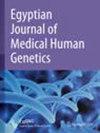Altered expression of long non-coding RNAs NRON and SNHG11 in patients with ischemic stroke
IF 1.2
Q4 GENETICS & HEREDITY
引用次数: 0
Abstract
Long non-coding RNAs, known as LncRNAs, have demonstrated a robust association with the pathogenesis of stroke. NRON and SNHG are among the most extensively studied lncRNAs in the context of atherosclerosis and inflammatory conditions. Given the absence of a current pathophysiological hypothesis regarding the potential relevance of the SNHG family and NRON lncRNAs in ischemic stroke (IS), this study aimed to investigate the altered expression of NRON and SNHG11 following atherosclerotic ischemic stroke (AIS) and their potential association with the risk of AIS. Blood samples were collected from 65 AIS patients (with large artery atherosclerosis or small vessel disease) and 65 controls. The expression levels of NRON and SNHG11 were assessed within the first 24 h following the stroke using quantitative real-time PCR. NRON expression exhibited a significant decrease in patients compared to controls, while no substantial difference was observed in the expression level of SNHG11 between the two groups. Furthermore, logistic regression analysis revealed a significant negative association between NRON expression and the risk of AIS (adjusted odds ratio = 0.70; 95% confidence interval 0.55–0.89, P = 0.004). These findings suggest that NRON may play a role in the pathogenesis of AIS and could potentially serve as a biomarker for the disease. To fully comprehend the mechanism underlying the association between NRON and AIS and to explore its potential therapeutic implications, further investigation is warranted.缺血性中风患者体内长非编码 RNA NRON 和 SNHG11 的表达改变
被称为 LncRNA 的长非编码 RNA 与中风的发病机制有着密切的联系。NRON和SNHG是在动脉粥样硬化和炎症条件下研究最广泛的lncRNA之一。鉴于目前还没有关于 SNHG 家族和 NRON lncRNA 与缺血性中风(IS)潜在相关性的病理生理学假说,本研究旨在调查动脉粥样硬化性缺血性中风(AIS)后 NRON 和 SNHG11 表达的改变及其与 AIS 风险的潜在关联。本研究采集了65名AIS患者(大动脉粥样硬化或小血管疾病)和65名对照者的血样。采用定量实时 PCR 技术评估了中风后 24 小时内 NRON 和 SNHG11 的表达水平。与对照组相比,患者的 NRON 表达明显下降,而 SNHG11 的表达水平在两组之间没有发现明显差异。此外,逻辑回归分析显示,NRON表达与AIS风险之间存在显著的负相关(调整后的几率比=0.70;95%置信区间为0.55-0.89,P=0.004)。这些发现表明,NRON可能在AIS的发病机制中发挥作用,并有可能成为该疾病的生物标志物。为了充分理解NRON与AIS之间的关联机制,并探索其潜在的治疗意义,还需要进一步的研究。
本文章由计算机程序翻译,如有差异,请以英文原文为准。
求助全文
约1分钟内获得全文
求助全文
来源期刊

Egyptian Journal of Medical Human Genetics
Medicine-Genetics (clinical)
CiteScore
2.20
自引率
7.70%
发文量
150
审稿时长
18 weeks
 求助内容:
求助内容: 应助结果提醒方式:
应助结果提醒方式:


